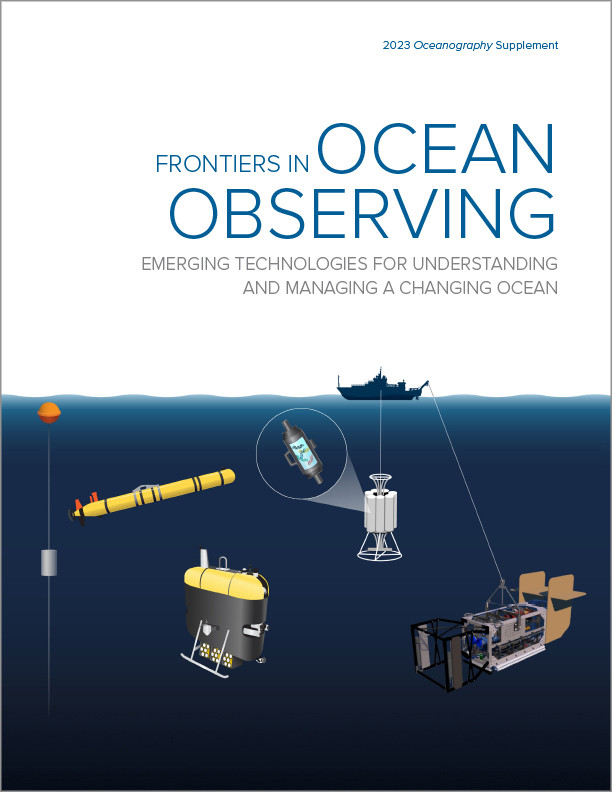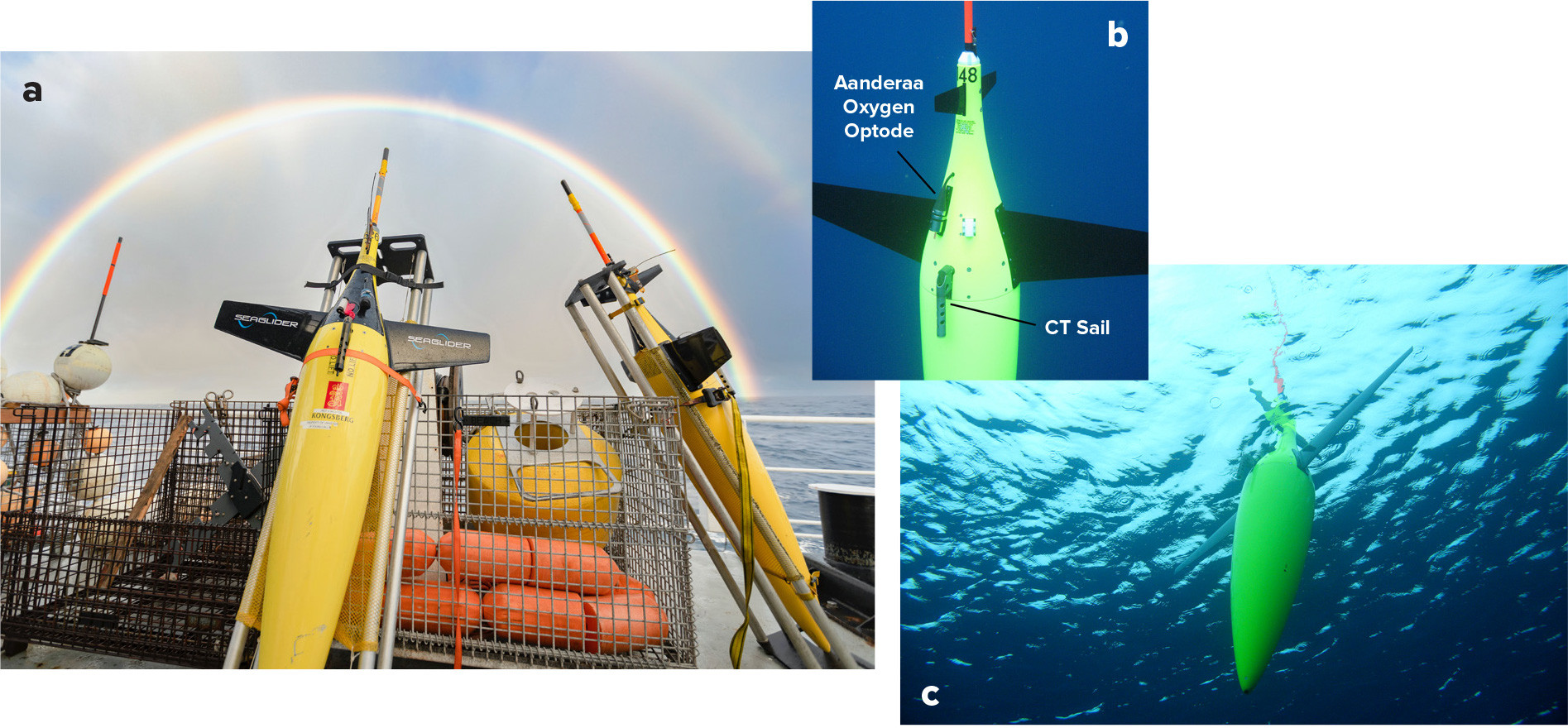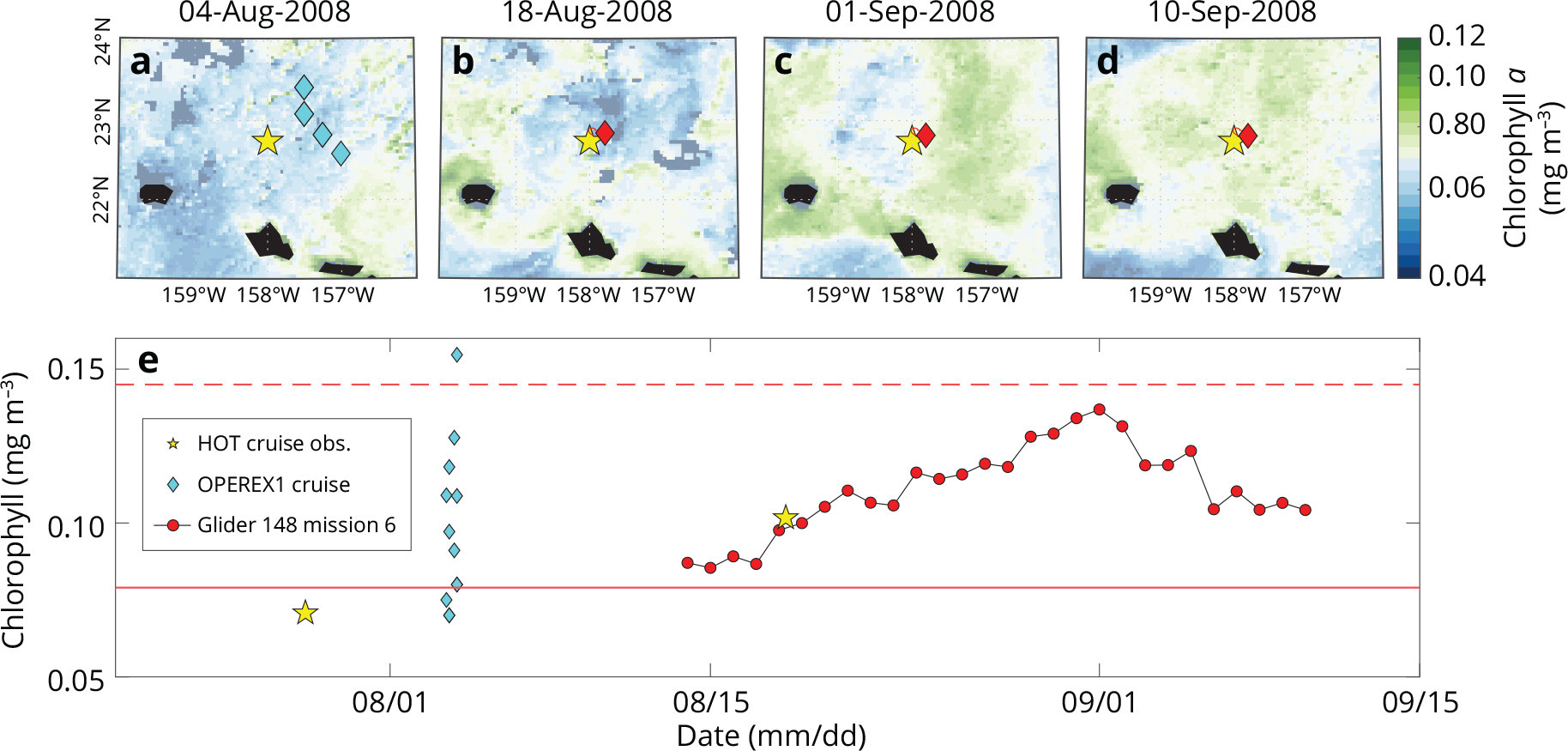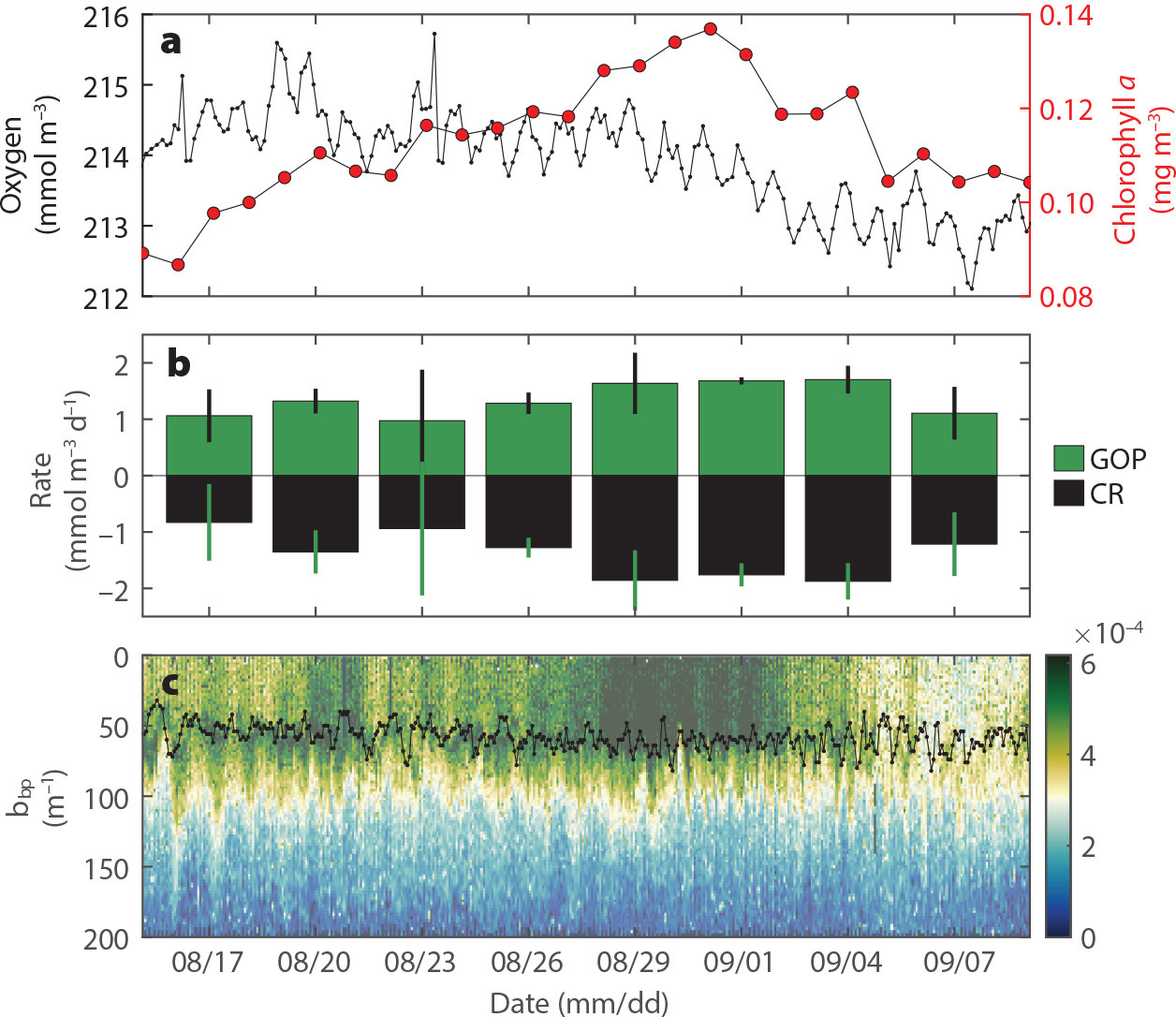Full Text
Biogenic particles originating in the ocean’s well-lit, shallow layer help regulate Earth’s climate by absorbing carbon dioxide from the atmosphere and subsequently sinking to the ocean’s depths. Subtropical gyres, the largest ocean habitats on Earth, are characterized by year-round high light, warm temperatures, and low supplies of nutrients. However, even in these persistently low-nutrient regions, conditions vary on multiple temporal and spatial scales, making low-frequency—even monthly—observations difficult to interpret.
Established in June 1988, the Hawaii Ocean Time-series (HOT) program measures carbon cycling and fluxes at Station ALOHA (A Long-term Oligotrophic Habitat Assessment; 22°45′N, 158°W) in the North Pacific Subtropical Gyre (NPSG). At this site, a predictable peak in particle sinking occurs in late summer, though the scale and magnitude vary annually (Karl et al., 2021). While the peak in primary productivity also occurs in late summer, directly linking primary production to particle export on interannual or intraseasonal scales remains challenging (Karl et al., 2021).
In addition to the expected increase in carbon export in the summer via sinking biogenic particles, there are also aperiodic phytoplankton blooms that are hard to predict. Summer phytoplankton blooms are vastly undersampled at Station ALOHA, despite 34 years of observations (Dore et al., 2008). As Dore et al. (2008) state: “Unfortunately, it is much more common in practice to observe the result of a bloom (an area of elevated phytoplankton biomass) than the mechanisms that led to its development.” As in the Dore et al. study, we define a bloom as a brief period (days to weeks) of rapidly increasing biomass.
Ocean-based carbon dioxide removal (CDR) strategies often involve taking advantage of the marine biological carbon pump (Siegel et al., 2021). Several CDR approaches consist of inputting nutrients near the ocean surface that stimulate photosynthesis and can increase the flux of organic carbon to the ocean interior. To verify the effectiveness of these approaches, open ocean experiments would require methods to estimate productivity and carbon accumulation in near-real time. Here, we propose that monitoring the open ocean ecosystem with autonomous underwater vehicles could provide useful metrics to quantify the stimulation of biogeochemical processes during CDR experiments. These efforts could initially focus on the subtropical gyres, whose vast area suggests a large capacity for carbon sequestration.
The gyre is not a homogeneous ecosystem. There are dynamic swings in productivity as mesoscale and submesoscale circulation features (e.g., eddies, fronts, and internal waves) alter environmental factors (light availability, temperature, and nutrient supply) that control phytoplankton growth. To constrain the environmental factors controlling the magnitude and timing of seasonal features (summer export pulses) and aperiodic events (summertime blooms) requires high-frequency sampling.
As part of this effort, autonomous underwater vehicles (Seagliders) have been deployed from ships in the vicinity of Station ALOHA for more than 16 missions since 2008 (Figure 1a). These Seagliders are equipped with CTD sensors that provide hydrography profiles of temperature, salinity, and pressure along with bio-optical and oxygen sensors that measure sub-daily, depth-resolved changes in oxygen concentration, chlorophyll a concentration, and optical backscatter as a proxy for particle concentration (Figure 1b). The Seagliders surface after each dive to transmit data via satellite and receive updated instructions on sampling location, depth, and frequency (Figure 1c). Thus, Seagliders can be used to characterize the variability of primary production, respiration, and particle dynamics to illuminate their relationship with high-productivity events. These events can serve as a framework for monitoring the short-term evolution of a water patch following “boom” and “bust” phases similar to that predicted during open ocean CDR experiments.
|
|
As a case study, we highlight data collected by a Seaglider mission near Station ALOHA in August and September 2008 (Figure 2b–d), when satellite imagery showed patches of elevated chlorophyll a concentration (Figure 2a–d). During this mission, the Seaglider measured chlorophyll a concentrations well above the climatological seasonal mean, even approaching two standard deviations above the mean (0.145 mg m–3) on August 31 and September 1 (Figure 2e). We define this accumulation of chlorophyll a concentrations as a bloom, because the accumulation occurred rapidly over two weeks. Shipboard sampling at Station ALOHA by the HOT program occurred at the end of July, in mid-August, and then in October. These measurements show elevated chlorophyll a concentration in August (Figure 2e, yellow stars), but the low sampling frequency of the ship-based observations cannot resolve the summer phytoplankton accumulation evident from Seaglider and satellite observations. Indeed, an oceanographic expedition to the east of Station ALOHA measured a large range of surface chlorophyll a concentrations over the course of a few days in August (Figure 2a, cyan diamonds).
|
|
On average, the Seaglider collected 16 profiles per day to 200 m, which allowed us to examine both long-term and short-term variability in oxygen concentrations. Seasonally, elevated temperature in late summer leads to outgassing and low surface oxygen (Figure 3a). At the daily scale, oxygen variability is dominated by photosynthesis and respiration, with rates that can be estimated from the shape of the diel oxygen variation (Barone et al., 2019). Using this method, we found that three-day average gross oxygen production (GOP) and community respiration (CR) were higher in late August/early September (Figure 3b). Increased production was linked with elevated particle backscattering and chlorophyll a (Figure 3a,c), suggesting particle accumulation and increased productivity during the bloom period.
|
|
Linking marine productivity to carbon export remains a challenge because only a small fraction of the carbon fixed by photosynthesis is exported below the euphotic zone (<10%), and there is likely a time lag between carbon fixation and export (Karl et al., 2021). For example, the Ocean Perturbation Experiment (OPEREX1) cruise shown in Figure 2a found evidence of increased particle flux where mixed layer chlorophyll a and particle concentrations were higher, but primary production was not enhanced (Guidi et al., 2012). Seagliders are well suited to document periodic changes in production leading up to pulsed export events. While shipboard primary production experiments are time-consuming and unrealistic to maintain beyond several days on station, Seagliders can remain in an area for upward of three months. With these production estimates, there is potential to determine time lags between production and export, and to identify the biological and physical forcings preceding high export events.
Understanding the dynamics that break this coupling and lead to high particle export events can direct future efforts for CDR technologies in nutrient-poor ecosystems. A recent study of CDR timescales suggests carbon exported to depth in the North Pacific Ocean remains sequestered far longer than in other ocean basins (Siegel et al., 2021). Thus, fast-sinking particles that reach the ocean bottom in the Pacific Ocean will more efficiently sequester carbon. Work at Station ALOHA shows that carbon sequestration depends on the species of nitrogen fixers driving new production (Dore et al., 2008; Karl et al., 2021): while fast-sinking endosymbiotic diatoms are detected at 4,000 m depth, more buoyant particles associated with Trichodesmium are presumably mineralized before reaching the ocean’s abyss.
An exciting development for autonomous underwater vehicles is the ability to attach compact underwater vision profilers to quantify and identify marine particles, including phytoplankton. Combined with novel methods for tracking productivity (Barone et al., 2019), Seagliders are poised to independently track gross oxygen production, community respiration, and particle accumulation that leads to export pulses. Seagliders cannot take discrete water samples; however, when paired with discrete sampling of sinking particle export, they can paint a high-resolution, three-dimensional picture of the water column leading up to enhanced carbon export.




